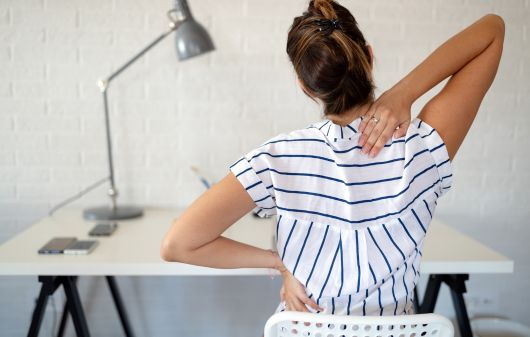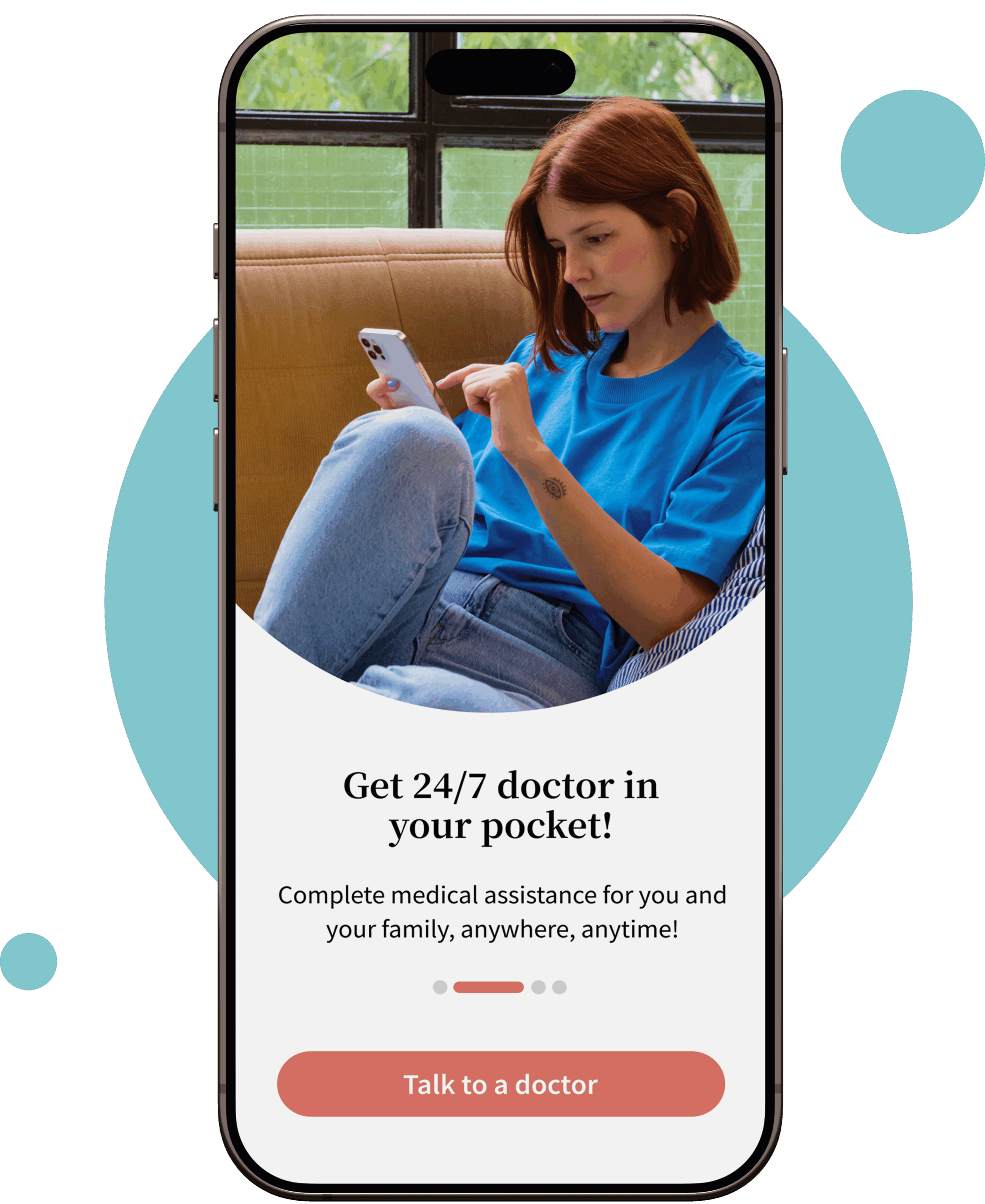
Get back pain treatment online
Back pain is a prevalent condition affecting millions globally. While preventive practices and at-home care can often alleviate discomfort, some cases require professional intervention.
Our experienced doctors specialize in diagnosing and treating back pain at Your Doctors Online. With convenient online consultations, you can receive personalized treatment and management strategies from the comfort of your home. Don’t let back pain affect your life. Consult us today for expert care.
What is back pain?
Back pain is a common condition experienced by up to 90% of individuals at some point in their lives. It can arise from various causes, including overuse, improper posture, or muscle strain. While occasional discomfort is normal, severe or persistent pain that interferes with daily activities may indicate underlying issues.
Back pain symptoms
Back pain can occur in various ways, and recognizing its symptoms is crucial for immediate treatment and management. Common back pain symptoms include:
- Ache or pain in the back, particularly when lifting objects or bending.
- Experiencing worsened pain when resting, sitting, or standing for extended periods.
- Muscle pain and stiffness, often felt in the lower back.
- Muscle weakness, making it challenging to perform daily activities.
- Pain in the back and abdominal muscles, sometimes accompanied by spasms.
- Potentially, pain radiating down the leg, known as sciatica, can cause discomfort in the buttocks, legs, or feet.
- Stiffness in the back, especially noticeable in the morning upon waking.
- Pain that radiates from the back to other areas of the body, such as the buttocks, legs, or abdomen.
Pay attention to these symptoms and seek medical advice if you experience persistent or severe back pain, as it may indicate underlying issues that require treatment.
Back pain causes
Back pain can stem from various factors, and it may differ from person to person. While some may experience sudden discomfort from muscle strains, others may endure chronic pain due to underlying conditions. Here are some common causes of back pain:
- Muscle Sprains: Heavy lifting, sudden movements, or bending over can strain back muscles, resulting in severe pain.
- Ruptured Disks: The vertebrae in the spine are cushioned by discs, and when these discs rupture or herniate, they can compress nearby nerves, causing pain. Common areas for disc issues are the lumbar region (L4, L5, S1).
- Arthritis: Aging can lead to arthritis, particularly osteoarthritis, which affects the joints, including those in the back. Arthritis-related back pain often worsens with age but can be managed with heat therapy and muscle-strengthening exercises.
- Osteoporosis: This bone disease weakens bones, making them prone to fractures, including compression fractures in the spine. Preventive measures such as making the home fall-safe are essential for individuals with osteoporosis.
- Structural Problems: Structural issues like degenerative disc disease, herniated discs, scoliosis, spinal stenosis, and spondylolisthesis can cause back pain. These conditions often require imaging tests for diagnosis and may necessitate specialized treatment.
Chronic back pain causes
Chronic neck and back pain can arise from various issues:
- Tendonitis or tendinopathy: Inflammation or degeneration of tendons can cause back and neck pain.
- Osteoarthritis: Degeneration of joint cartilage leads to pain and stiffness in the back.
- Degenerative conditions, including disc disease: Gradual loss of normal spinal structure and function over time.
- Herniated or bulging discs: Displacement of spinal discs can compress nerves and cause pain.
- Spinal Stenosis: Narrowing the spinal canal can pressure nerves and the spinal cord.
- Scoliosis: Abnormal curvature of the spine can lead to chronic discomfort.
- Spinal cord injury: Trauma to the spinal cord can result in persistent back pain.
Identifying the specific cause of your back pain is crucial for developing an effective treatment plan. Whether you’re experiencing muscle strains, degenerative conditions, or structural abnormalities, seeking medical evaluation and personalized care can help alleviate your symptoms and improve your quality of life.

What is the treatment for acute and chronic back pain?
Treatment for back pain varies based on symptoms and severity:
Acute back pain
- Rest for a day or two, avoiding prolonged bed rest.
- Over-the-counter pain medication, muscle relaxers, and hot/cold therapy.
- Physical therapy may help relieve pain and promote recovery.
Chronic back pain
Expert evaluation is recommended before surgical treatment. Treatment options may include:
- Spinal injections for immediate relief.
- Depending on the diagnosis, procedures like disc replacement, laminectomy, or fusion.
- Medications, including cortisone injections and nonsteroidal anti-inflammatory drugs.
- Alternative therapies like physical therapy or massage therapy to strengthen muscles and reduce tension.
- Seek medical attention if back pain persists after a few weeks.
Back pain medication we prescribe
How to prevent back pain?
- Stay active: Regular exercise helps maintain weight, build strong muscles, and improve blood flow, reducing the risk of back injuries.
- Use proper lifting techniques: Lift with your legs, not your back, and engage your core muscles to support your spine.
- Maintain good posture: Sit and stand upright to alleviate pressure on your back muscles.
- Stretch regularly: Stretching improves flexibility and reduces stiffness, lowering the risk of back pain.
- Stay healthy: Excess weight can strain your back, so aim for a healthy weight through diet and exercise.
How to connect with doctor for back pain
Connect with a health care professional online in 3 easy steps.
1
Describe your issue
Download our app, register and tell us about your medical issue to get started.
- Back Pain
- Anemia
- STD
- UTI
- Skin
- Covid
2
Chat with a doctor
Connect with a board-certified doctor. You can chat, send pictures and videos.
Hi Dr. Nicole, I have severe back pain. Can you help me?
3
Get prescription
Our online doctors can help you with your medical issues and give you prescriptions.
Prescription
- Diclofenac Gel 1%: Apply 2g to the affected areas four times a day for three weeks
- Naproxen Tablet 500mg: Twice a day for a week
Send Prescription
FAQs about back pain
What is the fastest way to relieve back pain?
You can treat back pain rapidly with medications. Medications like pain relievers (acetaminophen), non-steroidal anti-inflammatory drugs (naproxen), or in severe cases, opioids or antidepressants can help relieve the backache.
What kind of back pain should I see a doctor for?
If your back pain is due to mild injury, your primary care doctor will recommend muscle relaxants and pain relief medications. However, if your pain radiates and is not going away for days and accompanies swelling, tingling of legs, and numbness, see a concerned doctor immediately.
Can telehealth help with back pain?
Telemedicine allows for consultations from the comfort of your home, avoiding traffic and long waits at the doctor's office. It's beneficial for discussing symptoms and treatment options with healthcare providers remotely.
Which doctor to consult for lower back pain?
An orthopedic doctor will conduct a physical evaluation and may order X-rays or an MRI to diagnose lower back issues. They specialize in musculoskeletal conditions and can provide comprehensive care for back pain.
What does the doctor recommend for back pain?
Physiatrists, rheumatologists, and physical therapists specialize in treating back pain and related conditions. They offer various treatment options, including medications, therapies, and exercise programs tailored to individual needs.
How do I know if my back pain is serious?
Seek medical attention if your pain persists after a few weeks or if you experience numbness, tingling, or severe pain after an injury. These symptoms may indicate underlying issues requiring medical evaluation and treatment.
What does neurological back pain feel like?
Neurological back pain may include sharp, stabbing sensations, burning or pricking sensations, and radiating pain into the leg. These symptoms may indicate nerve compression or damage, requiring immediate medical attention.
How long does it take to heal a lower back strain?
Most lower back strains and sprains recover within 2 weeks, with over 90% fully recovering within a month. Avoiding vigorous exercise for 8 weeks can prevent further damage and facilitate healing. Physical therapy may also help speed up recovery and prevent recurrence.
What is the best prescription medicine for lower back pain?
Muscle relaxants like cyclobenzaprine, metaxalone, and tizanidine can help ease muscle spasms. They are often prescribed with other medications or therapies to alleviate back pain and improve mobility.
How do you relieve back pain during pregnancy?
Back pain is common during pregnancy due to the child's weight. Sometimes the pressure baby puts is higher due to the movement and position, causing severe back pain. It can be relieved with medications, improving sleeping or sitting posture, applying cold or hot compress, massaging the affected area, and including light physical activity in your routine.
What happens if lower back pain is left untreated?
If the actual cause of the back pain is not treated timely, it can cause disability, and the patient is more prone to serious health conditions due to impaired physical activity. Consult a doctor at Your Doctors Online for the treatment of lower back pain without further delays.
How to get rid of lower back pain right side above the buttocks?
Lower back pain on the right side can be sacroiliitis which is sacroiliac joint inflammation and usually resolves with rest, cold and hot compress, changing posture or sleeping position, and taking non-steroidal anti-inflammatory drugs (NSAIDs) to help with pain and reduce the inflammation.
-Phindile Mkhatshwa
-brooke snow
-Okiti Stephanie
-ASIF Khan
-Chelsey
-edith bien aime
-Lesego Thejane
-Stephanie Brown
-kulwinder gill
-Elijah Mark
Get Started Today
Talk to online doctors now and get medical advice, online prescriptions, refills, lab requisitions and medical notes within minutes. On-demand healthcare services at your fingertips.





